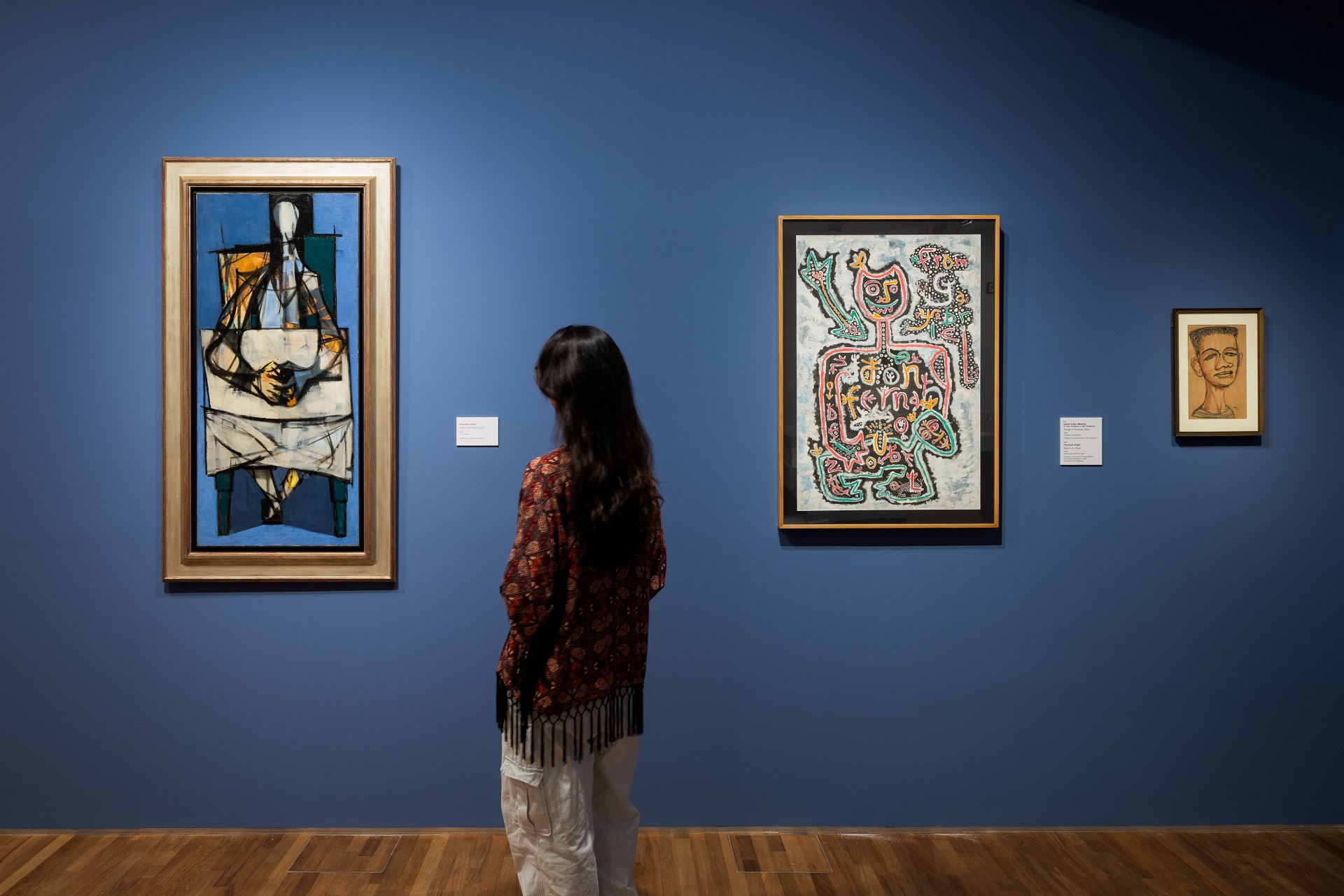The Cultural Center of the Philippines (CCP), through its Visual Arts and Museum Division, has loaned five significant artworks from its collection to the National Gallery Singapore (NGS), reinforcing its ongoing efforts to bring Philippine art to a wider international audience. This initiative not only showcases the depth of Filipino creativity but also helps strengthen cultural ties across Southeast Asia, fostering greater appreciation and collaboration in the region’s vibrant arts scene.
The artworks from the CCP 21st Century Art Museum (21AM) Collection — Painting No. 1 by National Artist Jose Joya; Portrait of Fernando Zóbel and Fernando Zóbel Lecturing on Art and a Student Listening II, both by David Cortez Medalla; Calligraphic Oracle by Manuel Rodriguez Sr.; and Ku III by Fernando Zóbel — are featured in NGS’s first-ever solo exhibition dedicated to transcontinental abstract artist Fernando Zóbel (1924–1984).
Born in the Philippines to a prominent Spanish family, Zóbel was an avid traveler, a cosmopolitan thinker and writer, and a pioneering collector who established two modern art museums in the Philippines and Spain. His lifelong, wide-ranging interests shaped his expressionist and abstract works in drawing, printmaking, painting, and photography.
He held his first solo exhibition at the Philippine Art Gallery in 1952, invigorating the postwar art scene in the country. In 1960, Zóbel left the family business in the Philippines to fully devote himself to artistic pursuits.
The inaugural showcase of his works in Singapore, the exhibition Fernando Zóbel: Order is Essential, introduces this legendary visual artist to new audiences, offering insights into his multifaceted contributions as an artist, patron, collector, and scholar. Featuring over 200 pieces — including paintings, drawings, prints, photographs, and archival materials — the exhibition highlights Zóbel’s role in bridging cultural contexts and enriching global dialogues on modern art.
Zóbel’s Ku III, part of his renowned Ku series, exemplifies his deeply personal and abstract style, marked by delicate color palettes and expressive, nuanced brushwork. This piece underscores the artist’s distinctive contribution to abstract expressionism.
According to the CCP Encyclopedia of Philippine Art, David Medalla’s Portrait of Fernando Zóbel marks an early phase in the artist’s exploration of unconventional expression. The work emphasizes the flatness of the canvas through simple, linear forms inspired by children’s drawings and so-called “primitive” art. It also reflects a strong Dadaist influence and aligns with the raw aesthetic of Art Brut, blending satire and playfulness – characteristics that later became hallmarks of Medalla’s practice.
In the portrait, the usually refined and esteemed business tycoon Zóbel is reimagined through a whimsical lens. Using mixed media on black paper, Medalla transforms him into a playful figure with an exaggerated grin, subverting the formality typically associated with portraiture.
The piece was part of Medalla’s debut solo exhibition, which featured large-scale paintings incorporating unconventional materials such as sand, seashells, and gravel with oil paint. This portrait is one of three paintings depicting Zóbel in the CCP 21AM Collection; the others are also titled Portrait of Fernando Zobel and made in 1956.
In Fernando Zóbel Lecturing on Art and a Student Listening II, Medalla uses pen and ink on paper to depict Zobel, who was widely known for his Saeta series.
Reflecting the development of Philippine modern art, Manuel Rodriguez Sr. presents a collograph with orange linear strokes dominated by a deep green background in his work, Calligraphic Oracle.
Painting No.1 by National Artist Jose Joya depicts his abstract expressionist influence through bold images of irregular geometric shapes with overlapping patterns. This style was influenced by his travels and studies in Spain in Europe.
Named after Zóbel’s famous remark that guided his artistic practice, the exhibition sheds light on a lesser-known aspect of his abstraction – a meticulous and controlled creative process involving multiple iterations before finalizing each work.
Fernando Zóbel: Order is Essential follows the exhibit Zóbel: The Future of the Past, which opened at Museo Nacional del Prado (2022) in Spain and was later restaged at the Ayala Museum (2024) in the Philippines. Expanding on key narratives, NGS’s distinct and refreshed iteration introduces exclusive works and offers a unique perspective on Zóbel’s artistic evolution and transcontinental practice.
Spanning two gallery spaces, the exhibition is organized into five sections: “Half of This Haunted Monk’s Life,” “With Every Single Refinement,” “Thin Lines Against a Field of Colour,” “Movement That Includes Its Own Contradiction,” and “The Light of the Painting.”
Each section traces a phase in Zóbel’s artistic development – from his early years to his formative period in New England, his reconnection with his Filipino roots, his journey into abstraction and monochrome, and finally, his fascination with motion and the passage of time in his later years.
The exhibit opened on May 9 and will run until November 30, 2025, at the Wu Guanzhong Gallery and Level 4 Gallery at National Gallery Singapore.
For more information on Fernando Zóbel: Order is Essential, visit: https://www.nationalgallery.sg/sg/en.html. To get latest on the CCP 21AM Collection, visit the CCP website (www.culturalcenter.gov.ph).




